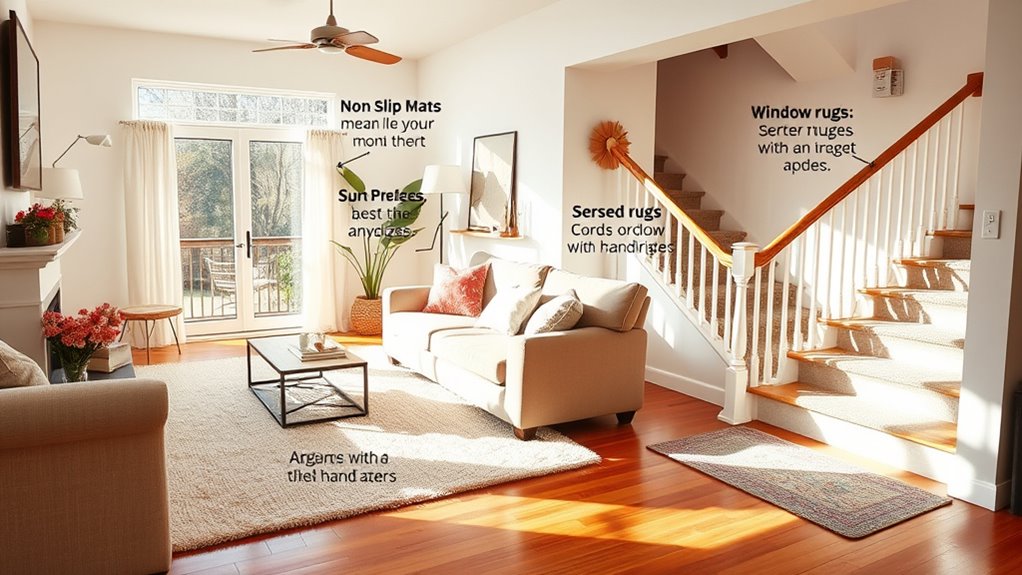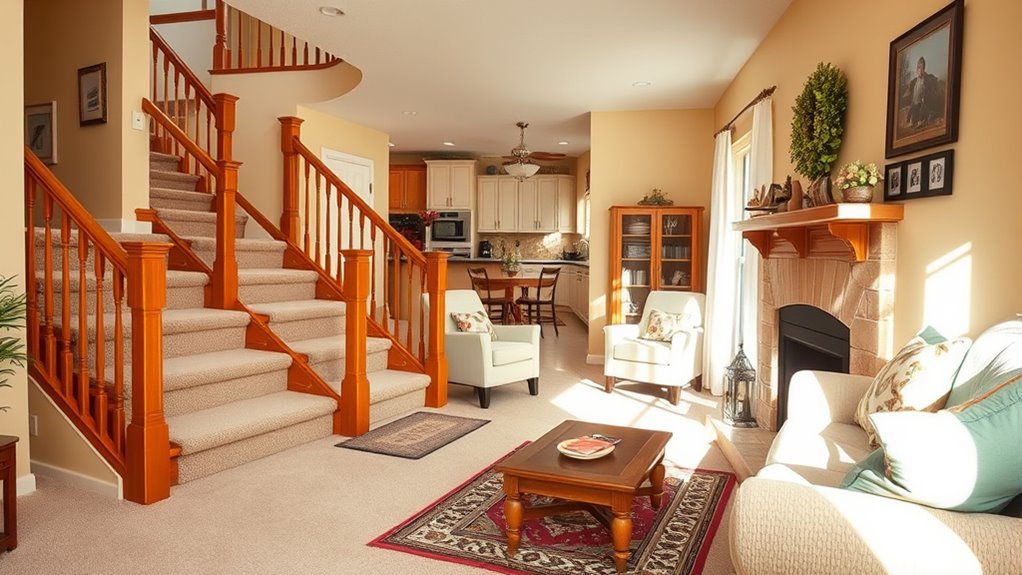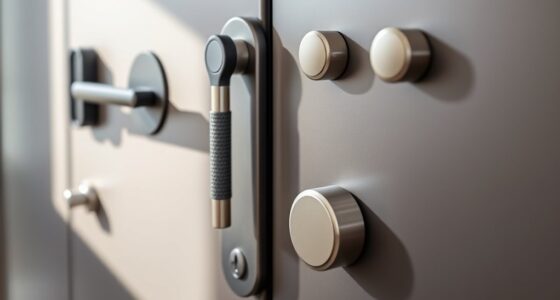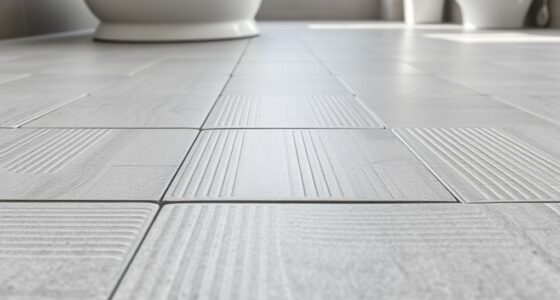To fall-proof your home in 24 hours, start by securing sturdy handrails on both sides of your stairs and adding non-slip treads. In bathrooms, install grab bars and swap slippery mats for textured, non-slip options. Clear clutter from walkways, improve lighting, and keep frequently used items within reach. Focus on these key areas first for quick safety wins. Keep exploring for more tips to make your entire home safer quickly and easily.
Key Takeaways
- Prioritize stair and bathroom safety by installing grab bars, non-slip treads, and ensuring proper lighting.
- Remove clutter, loose rugs, and cords from walkways to prevent tripping hazards throughout the home.
- Add bright, motion-activated lighting in key areas to improve visibility at night.
- Make quick modifications like securing handrails and adding non-slip strips within 24 hours.
- Conduct a room-by-room safety check to identify and address potential fall risks promptly.
Room-by-Room Fall Prevention Tips

Falling at home can happen in an instant, but with a focused plan, you can make your space safer in just 24 hours. The first step is to address common fall hazards, especially in high-risk areas like stairs and bathrooms. Stair safety is vital because stairs are often where falls occur. Check that your stairs have sturdy handrails on both sides and verify they’re securely anchored. Remove loose rugs or clutter that could cause tripping, and add non-slip treads or strips to increase traction. Good lighting is essential; install bright, motion-activated lights if necessary, so you can see every step clearly, especially at night. These small adjustments can substantially reduce your risk of falling on stairs.
Secure stairs with sturdy handrails and good lighting to prevent falls at home.
Next, turn your attention to the bathroom, which is another common spot for falls. Bathroom modifications greatly enhance safety, so start by installing grab bars near the toilet and inside the shower or tub. These bars offer support when you’re getting in and out, preventing slips. Replace slippery mats with non-slip ones, and consider adding textured tiles or mats with grip to improve stability. Make sure your bathroom has proper lighting, preferably with night lights that turn on automatically. If your bathroom has a step or a high threshold, consider lowering or eliminating it, or installing a walk-in shower with a low or zero-threshold entry. Also, check that your sink and countertops are at safe heights, making it easier to maintain balance and avoid sudden trips or slips.
In addition to stair safety and bathroom modifications, look around each room for other hazards. Clear walkways of cords, clutter, and loose rugs. Install adequate lighting and grab bars where needed. Place frequently used items within easy reach to avoid overstretching or bending awkwardly. Remember, most accidents happen because of simple oversights, so these quick fixes can make a big difference. Incorporating home safety technology, such as sensor lights or fall detection devices, can further enhance your home’s safety. With just a few hours of effort, you can transform your home into a safer environment, reducing your risk of falls and giving you peace of mind.
Taking these steps in a focused, room-by-room manner ensures you don’t miss essential areas. Prioritize stairs and bathrooms first, then move on to other spaces. The goal is to create a home that supports your mobility and independence while minimizing hazards. With a little effort and attention to detail, you can fall-proof your home in just 24 hours, making your environment safer for yourself and loved ones.
Frequently Asked Questions
How Often Should I Inspect Fall Prevention Measures?
You should inspect fall prevention measures at least once a month to guarantee your home remains safe. Make home maintenance a priority by following a safety checklist, checking for loose rugs, handrail stability, and clear walkways. Regular inspections help catch potential hazards early, reducing fall risks. Staying proactive keeps your environment safe and secure, giving you peace of mind knowing you’ve minimized hazards effectively.
Are There Specific Fall-Proofing Products for Seniors?
Imagine stepping onto a bathroom with non-slip mats and grab bars, feeling secure and steady. For senior safety, there are specific fall-proof products designed to keep you safe—raised toilet seats, sturdy handrails, and shower chairs. These fall-proof products improve stability and reduce fall risks, giving you confidence in your daily routines. Incorporating them guarantees your home becomes a safer space tailored to meet your needs.
Can Fall Prevention Tips Be Customized for Pets?
You can definitely customize fall prevention tips for pets by focusing on pet safety and pet-friendly modifications. Start by removing tripping hazards, securing loose rugs, and adding non-slip mats in slippery areas. Use baby gates to restrict access to risky spots, and make certain pet furniture is stable. Regularly check for hazards, keep floors clean, and create a safe environment tailored to your pet’s needs, helping prevent falls and injuries.
What Is the Cost Range for Comprehensive Fall-Proofing?
The cost range for all-encompassing fall-proofing varies widely, depending on your home’s size and the level of modifications needed. Cost considerations include installing grab bars, securing rugs, and improving lighting. To stay within your budget, plan carefully and prioritize essential safety upgrades first. Budget planning helps you allocate funds effectively, ensuring you create a safer environment without overspending. This way, you can fall-proof your home efficiently and affordably.
How Do I Involve Family Members in Safety Improvements?
They say “many hands make light work,” and involving your family makes safety improvements easier. Engage them in safety education by discussing fall risks and solutions together. Assign simple tasks like securing rugs or installing grab bars. When everyone participates, they feel responsible and aware, creating a safer environment. Your involvement fosters teamwork, making fall-proofing a shared effort that benefits the whole family’s well-being.
Conclusion
By taking these simple steps, you’re building a safety net that catches you before a fall happens. Think of your home as a garden—you’re the gardener, tending to each detail to guarantee everything grows strong and steady. With a little effort today, you’ll create a haven where falls are just a shadow of the past. Remember, a safe home isn’t just built; it’s nurtured—so keep watering those safety measures.









